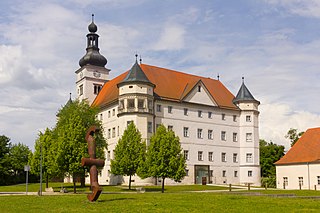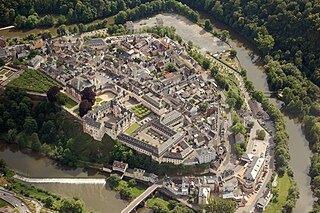
Neuschwanstein Castle is a 19th-century Romanesque Revival palace on a rugged hill above the village of Hohenschwangau near Füssen in southwest Bavaria, Germany. The palace was commissioned by Ludwig II of Bavaria as a retreat and in honour of Richard Wagner. Ludwig paid for the palace out of his personal fortune and by means of extensive borrowing, rather than Bavarian public funds.

Frederiksborg Castle is a palatial complex in Hillerød, Denmark. It was built as a royal residence for King Christian IV of Denmark-Norway in the early 17th century, replacing an older castle acquired by Frederick II and becoming the largest Renaissance residence in Scandinavia. Situated on three islets in the Slotssøen, it is adjoined by a large formal garden in the Baroque style.

The Schleissheim Palace comprises three individual palaces in a grand baroque park in the village of Oberschleißheim, a suburb of Munich, Bavaria, Germany. The palace was a summer residence of the Bavarian rulers of the House of Wittelsbach.

Schloss Hartheim, also known as Hartheim Castle, is a castle at Alkoven in Upper Austria, some 14 kilometres (9 mi) from Linz, Austria. It was built by Jakob von Aspen in 1600, and it is a prominent Renaissance castle in the country. The building became notorious as one of the Nazi Euthanasia killing centers, where the killing program Action T4 took place.

The Old Castle is a former castle located on the Schillerplatz in Stuttgart, Germany. The castle, originally a water castle dating back to the 10th Century, was the residence of the Counts and later some Dukes of Württemberg and today is the home of the Landesmuseum Württemberg. The castle church still functions as a place of worship.

Bled Castle is a medieval castle built on a precipice above the city of Bled in Slovenia, overlooking Lake Bled. According to written sources, it is the oldest Slovenian castle and is currently one of the most visited tourist attractions in Slovenia.

Clausholm Castle is a large Danish country house located some 12 km southeast of Randers in eastern Jutland. It is one of Denmark's finest Baroque buildings.

Erbach Castle is a patrician Renaissance castle situated on a hillside close to the city of Erbach an der Donau in the state of Baden Württemberg, Germany. The current owner is Baron zu Ulm-Erbach.

Pillnitz Castle is a restored Baroque palace at the eastern end of the city of Dresden in the German state of Saxony. It is located on the bank of the River Elbe in the former village of Pillnitz. Pillnitz Castle was the summer residence of many electors and kings of Saxony; it is also known for the Declaration of Pillnitz in 1791.

Schwarzenburg Castle is a castle in the municipality of Schwarzenburg of the Canton of Bern in Switzerland. It is a Swiss heritage site of national significance.

Saarbrücken Castle is a Baroque Château in Saarbrücken, the capital of Saarland. It is located in the district of Alt-Saarbrücken on the left bank of the Saar. Earlier, a medieval castle and a Renaissance castle stood on the same site.

Seefeld Castle is a castle in Seefeld, Bavaria that has its origins in a 13th-century building but has since been extensively modified. Today it serves in part as a museum. A large park extends to the south of the castle.

Affing House is a stately home in Affing, Bavaria, Germany that has its origins in an early moated castle. It was the seat of a hofmark, a Bavarian feudal estate. After the old castle was destroyed, the schloss was built in 1682. It was burned down in 1927, but was rebuilt following the original design as closely as possible.

Sandersdorf Castle is a castle, or stately house, in the village of Sandersdorf in Altmannstein, to the northeast of Ingolstadt, Bavaria, Germany. The present building dates to 1646, and was restored in 1900.

Schloss Fußberg is a stately house in the village of Gauting, Bavaria, Germany dating from 1721.

The castle in Forchheim, also referred to as a royal palace or Kaiserpfalz, was an important urban castle under the bishops of Bamberg in the town of Forchheim in the south German state of Bavaria. The castle was built in the late 14th century. After comprehensive archaeological and architectural-historical investigation it has become one of the best researched castles of this period in Central Europe. Today it houses the Archaeological Museum of Upper Franconia.

The Schloss Wolfenbüttel is a castle in the town of Wolfenbüttel in Lower Saxony in Germany. As an extensive four-wing complex, it originated as a moated castle. It is the second-largest surviving schloss in Lower Saxony and served as the main residence for the Principality of Brunswick-Wolfenbüttel between 1432 and 1753. It is now used by a secondary school, the Federal Academy of Arts Education and a museum. In the immediate vicinity are the Herzog August Bibliothek, the Lessinghaus, the Zeughaus and the Kleine Schloss.
The Margrave Fountain is a fountain in Bayreuth, Germany. It was built as a monument for Margrave Christian Ernest of Brandenburg-Bayreuth after he had participated in the liberation of Vienna, which had been besieged by the Turks in 1683. The Margrave's equestrian statue is placed in the centre of the fountain, surrounded by other sculpture groups representing the four known continents as well as four rivers rising in the Fichtel Mountains.

Schloss Weilburg is a Baroque schloss in Weilburg, Hesse, Germany. It is located on a spur above the river Lahn and occupies about half of the area of the Old Town of Weilburg. It contains the Hochschloss, built between 1530 and 1572, which is one of the best-preserved Renaissance palaces in Hesse. In the 1700s, the palace was expanded by John Ernst, Count of Nassau-Weilburg, and his builder, Julius Ludwig Rothweil. The buildings and gardens now belong to the Verwaltung der Staatlichen Schlösser und Gärten Hessen, and they can be visited as a museum on guided tours. Parts of the palace are venues for the music festival Weilburger Schlosskonzerte, which is named after the palace.




























